The Sydney Opera House Project Evaluation Report
VerifiedAdded on 2022/08/17
|15
|5033
|14
AI Summary
The Sydney Opera House is an exemplary Australian building with a long-standing history of innovative information management. This history begins with a challenging plan and development process which incited what might be the primary field-to-finish framework for surveyors in Australia making incredible productivity picks up, and presently proceeds with the execution of what is anticipated to be a completely integrated Business Information Modelling for asset management framework. There were two primary stakeholders at the starting of the Sydney Opera House development, Jorn Utzon and
Contribute Materials
Your contribution can guide someone’s learning journey. Share your
documents today.
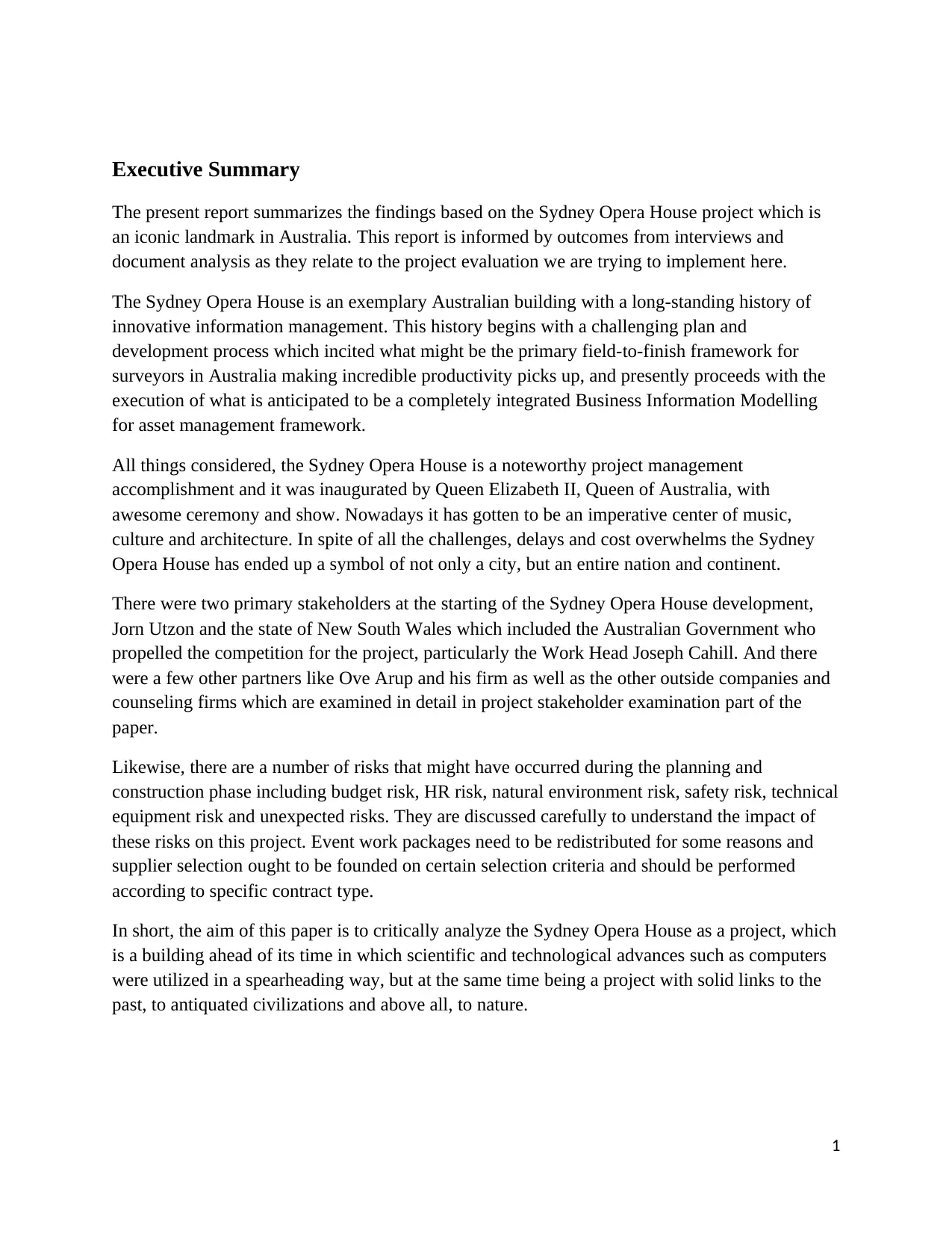
Executive Summary
The present report summarizes the findings based on the Sydney Opera House project which is
an iconic landmark in Australia. This report is informed by outcomes from interviews and
document analysis as they relate to the project evaluation we are trying to implement here.
The Sydney Opera House is an exemplary Australian building with a long-standing history of
innovative information management. This history begins with a challenging plan and
development process which incited what might be the primary field-to-finish framework for
surveyors in Australia making incredible productivity picks up, and presently proceeds with the
execution of what is anticipated to be a completely integrated Business Information Modelling
for asset management framework.
All things considered, the Sydney Opera House is a noteworthy project management
accomplishment and it was inaugurated by Queen Elizabeth II, Queen of Australia, with
awesome ceremony and show. Nowadays it has gotten to be an imperative center of music,
culture and architecture. In spite of all the challenges, delays and cost overwhelms the Sydney
Opera House has ended up a symbol of not only a city, but an entire nation and continent.
There were two primary stakeholders at the starting of the Sydney Opera House development,
Jorn Utzon and the state of New South Wales which included the Australian Government who
propelled the competition for the project, particularly the Work Head Joseph Cahill. And there
were a few other partners like Ove Arup and his firm as well as the other outside companies and
counseling firms which are examined in detail in project stakeholder examination part of the
paper.
Likewise, there are a number of risks that might have occurred during the planning and
construction phase including budget risk, HR risk, natural environment risk, safety risk, technical
equipment risk and unexpected risks. They are discussed carefully to understand the impact of
these risks on this project. Event work packages need to be redistributed for some reasons and
supplier selection ought to be founded on certain selection criteria and should be performed
according to specific contract type.
In short, the aim of this paper is to critically analyze the Sydney Opera House as a project, which
is a building ahead of its time in which scientific and technological advances such as computers
were utilized in a spearheading way, but at the same time being a project with solid links to the
past, to antiquated civilizations and above all, to nature.
1
The present report summarizes the findings based on the Sydney Opera House project which is
an iconic landmark in Australia. This report is informed by outcomes from interviews and
document analysis as they relate to the project evaluation we are trying to implement here.
The Sydney Opera House is an exemplary Australian building with a long-standing history of
innovative information management. This history begins with a challenging plan and
development process which incited what might be the primary field-to-finish framework for
surveyors in Australia making incredible productivity picks up, and presently proceeds with the
execution of what is anticipated to be a completely integrated Business Information Modelling
for asset management framework.
All things considered, the Sydney Opera House is a noteworthy project management
accomplishment and it was inaugurated by Queen Elizabeth II, Queen of Australia, with
awesome ceremony and show. Nowadays it has gotten to be an imperative center of music,
culture and architecture. In spite of all the challenges, delays and cost overwhelms the Sydney
Opera House has ended up a symbol of not only a city, but an entire nation and continent.
There were two primary stakeholders at the starting of the Sydney Opera House development,
Jorn Utzon and the state of New South Wales which included the Australian Government who
propelled the competition for the project, particularly the Work Head Joseph Cahill. And there
were a few other partners like Ove Arup and his firm as well as the other outside companies and
counseling firms which are examined in detail in project stakeholder examination part of the
paper.
Likewise, there are a number of risks that might have occurred during the planning and
construction phase including budget risk, HR risk, natural environment risk, safety risk, technical
equipment risk and unexpected risks. They are discussed carefully to understand the impact of
these risks on this project. Event work packages need to be redistributed for some reasons and
supplier selection ought to be founded on certain selection criteria and should be performed
according to specific contract type.
In short, the aim of this paper is to critically analyze the Sydney Opera House as a project, which
is a building ahead of its time in which scientific and technological advances such as computers
were utilized in a spearheading way, but at the same time being a project with solid links to the
past, to antiquated civilizations and above all, to nature.
1
Secure Best Marks with AI Grader
Need help grading? Try our AI Grader for instant feedback on your assignments.
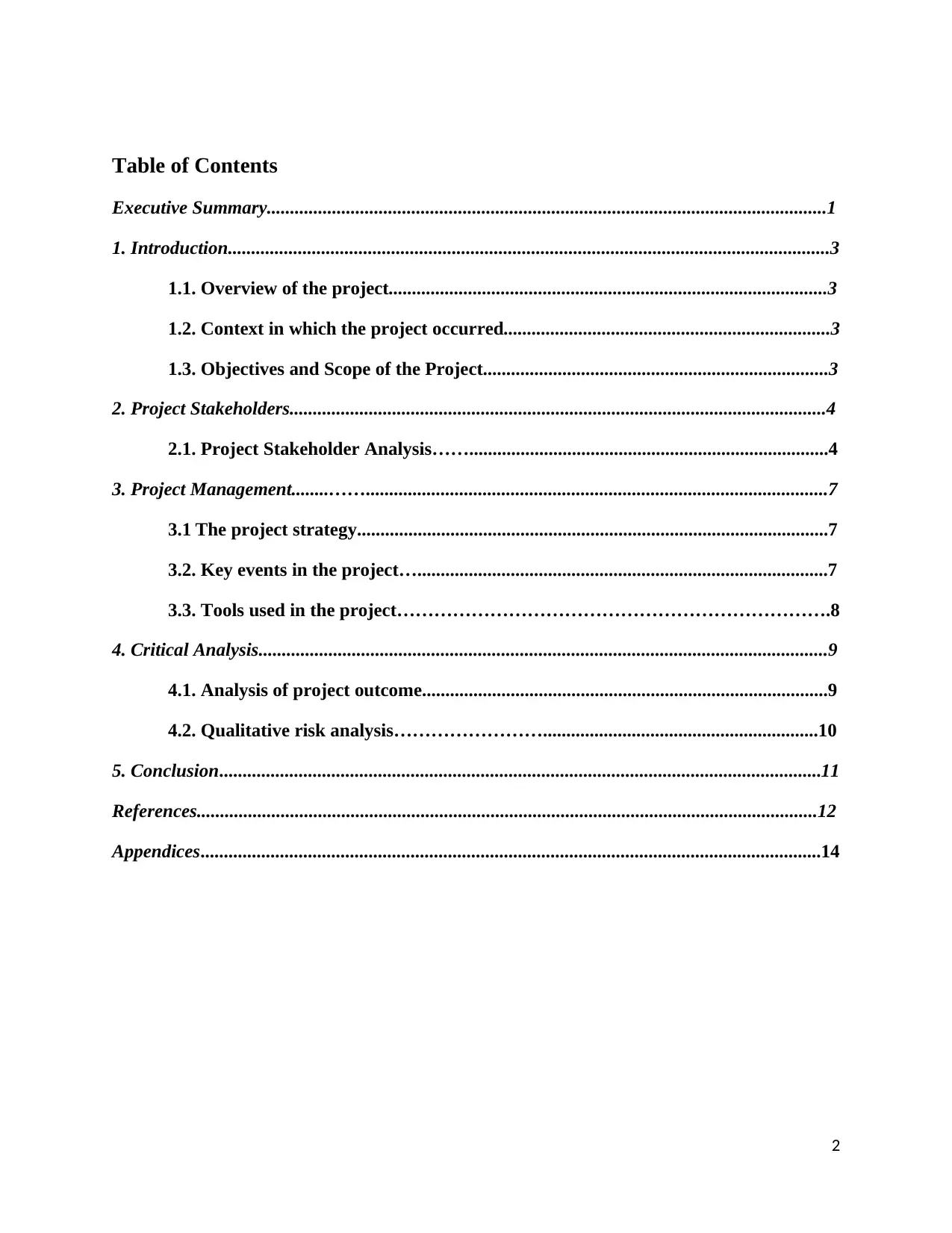
Table of Contents
Executive Summary........................................................................................................................1
1. Introduction.................................................................................................................................3
1.1. Overview of the project..............................................................................................3
1.2. Context in which the project occurred......................................................................3
1.3. Objectives and Scope of the Project..........................................................................3
2. Project Stakeholders...................................................................................................................4
2.1. Project Stakeholder Analysis…….............................................................................4
3. Project Management........……...................................................................................................7
3.1 The project strategy.....................................................................................................7
3.2. Key events in the project…........................................................................................7
3.3. Tools used in the project…………………………………………………………….8
4. Critical Analysis..........................................................................................................................9
4.1. Analysis of project outcome.......................................................................................9
4.2. Qualitative risk analysis……………………...........................................................10
5. Conclusion.................................................................................................................................11
References.....................................................................................................................................12
Appendices.....................................................................................................................................14
2
Executive Summary........................................................................................................................1
1. Introduction.................................................................................................................................3
1.1. Overview of the project..............................................................................................3
1.2. Context in which the project occurred......................................................................3
1.3. Objectives and Scope of the Project..........................................................................3
2. Project Stakeholders...................................................................................................................4
2.1. Project Stakeholder Analysis…….............................................................................4
3. Project Management........……...................................................................................................7
3.1 The project strategy.....................................................................................................7
3.2. Key events in the project…........................................................................................7
3.3. Tools used in the project…………………………………………………………….8
4. Critical Analysis..........................................................................................................................9
4.1. Analysis of project outcome.......................................................................................9
4.2. Qualitative risk analysis……………………...........................................................10
5. Conclusion.................................................................................................................................11
References.....................................................................................................................................12
Appendices.....................................................................................................................................14
2
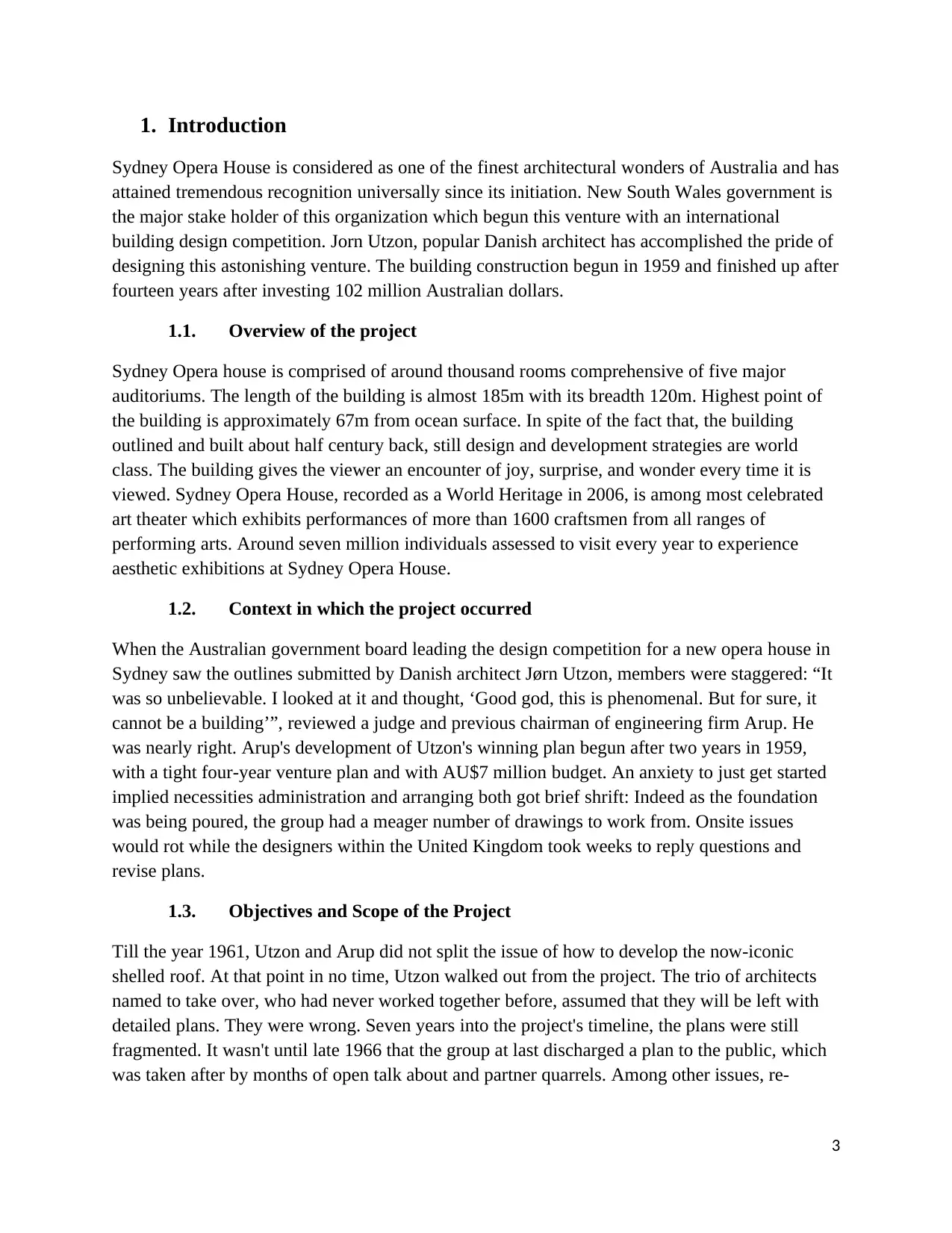
1. Introduction
Sydney Opera House is considered as one of the finest architectural wonders of Australia and has
attained tremendous recognition universally since its initiation. New South Wales government is
the major stake holder of this organization which begun this venture with an international
building design competition. Jorn Utzon, popular Danish architect has accomplished the pride of
designing this astonishing venture. The building construction begun in 1959 and finished up after
fourteen years after investing 102 million Australian dollars.
1.1. Overview of the project
Sydney Opera house is comprised of around thousand rooms comprehensive of five major
auditoriums. The length of the building is almost 185m with its breadth 120m. Highest point of
the building is approximately 67m from ocean surface. In spite of the fact that, the building
outlined and built about half century back, still design and development strategies are world
class. The building gives the viewer an encounter of joy, surprise, and wonder every time it is
viewed. Sydney Opera House, recorded as a World Heritage in 2006, is among most celebrated
art theater which exhibits performances of more than 1600 craftsmen from all ranges of
performing arts. Around seven million individuals assessed to visit every year to experience
aesthetic exhibitions at Sydney Opera House.
1.2. Context in which the project occurred
When the Australian government board leading the design competition for a new opera house in
Sydney saw the outlines submitted by Danish architect Jørn Utzon, members were staggered: “It
was so unbelievable. I looked at it and thought, ‘Good god, this is phenomenal. But for sure, it
cannot be a building’”, reviewed a judge and previous chairman of engineering firm Arup. He
was nearly right. Arup's development of Utzon's winning plan begun after two years in 1959,
with a tight four-year venture plan and with AU$7 million budget. An anxiety to just get started
implied necessities administration and arranging both got brief shrift: Indeed as the foundation
was being poured, the group had a meager number of drawings to work from. Onsite issues
would rot while the designers within the United Kingdom took weeks to reply questions and
revise plans.
1.3. Objectives and Scope of the Project
Till the year 1961, Utzon and Arup did not split the issue of how to develop the now-iconic
shelled roof. At that point in no time, Utzon walked out from the project. The trio of architects
named to take over, who had never worked together before, assumed that they will be left with
detailed plans. They were wrong. Seven years into the project's timeline, the plans were still
fragmented. It wasn't until late 1966 that the group at last discharged a plan to the public, which
was taken after by months of open talk about and partner quarrels. Among other issues, re-
3
Sydney Opera House is considered as one of the finest architectural wonders of Australia and has
attained tremendous recognition universally since its initiation. New South Wales government is
the major stake holder of this organization which begun this venture with an international
building design competition. Jorn Utzon, popular Danish architect has accomplished the pride of
designing this astonishing venture. The building construction begun in 1959 and finished up after
fourteen years after investing 102 million Australian dollars.
1.1. Overview of the project
Sydney Opera house is comprised of around thousand rooms comprehensive of five major
auditoriums. The length of the building is almost 185m with its breadth 120m. Highest point of
the building is approximately 67m from ocean surface. In spite of the fact that, the building
outlined and built about half century back, still design and development strategies are world
class. The building gives the viewer an encounter of joy, surprise, and wonder every time it is
viewed. Sydney Opera House, recorded as a World Heritage in 2006, is among most celebrated
art theater which exhibits performances of more than 1600 craftsmen from all ranges of
performing arts. Around seven million individuals assessed to visit every year to experience
aesthetic exhibitions at Sydney Opera House.
1.2. Context in which the project occurred
When the Australian government board leading the design competition for a new opera house in
Sydney saw the outlines submitted by Danish architect Jørn Utzon, members were staggered: “It
was so unbelievable. I looked at it and thought, ‘Good god, this is phenomenal. But for sure, it
cannot be a building’”, reviewed a judge and previous chairman of engineering firm Arup. He
was nearly right. Arup's development of Utzon's winning plan begun after two years in 1959,
with a tight four-year venture plan and with AU$7 million budget. An anxiety to just get started
implied necessities administration and arranging both got brief shrift: Indeed as the foundation
was being poured, the group had a meager number of drawings to work from. Onsite issues
would rot while the designers within the United Kingdom took weeks to reply questions and
revise plans.
1.3. Objectives and Scope of the Project
Till the year 1961, Utzon and Arup did not split the issue of how to develop the now-iconic
shelled roof. At that point in no time, Utzon walked out from the project. The trio of architects
named to take over, who had never worked together before, assumed that they will be left with
detailed plans. They were wrong. Seven years into the project's timeline, the plans were still
fragmented. It wasn't until late 1966 that the group at last discharged a plan to the public, which
was taken after by months of open talk about and partner quarrels. Among other issues, re-
3
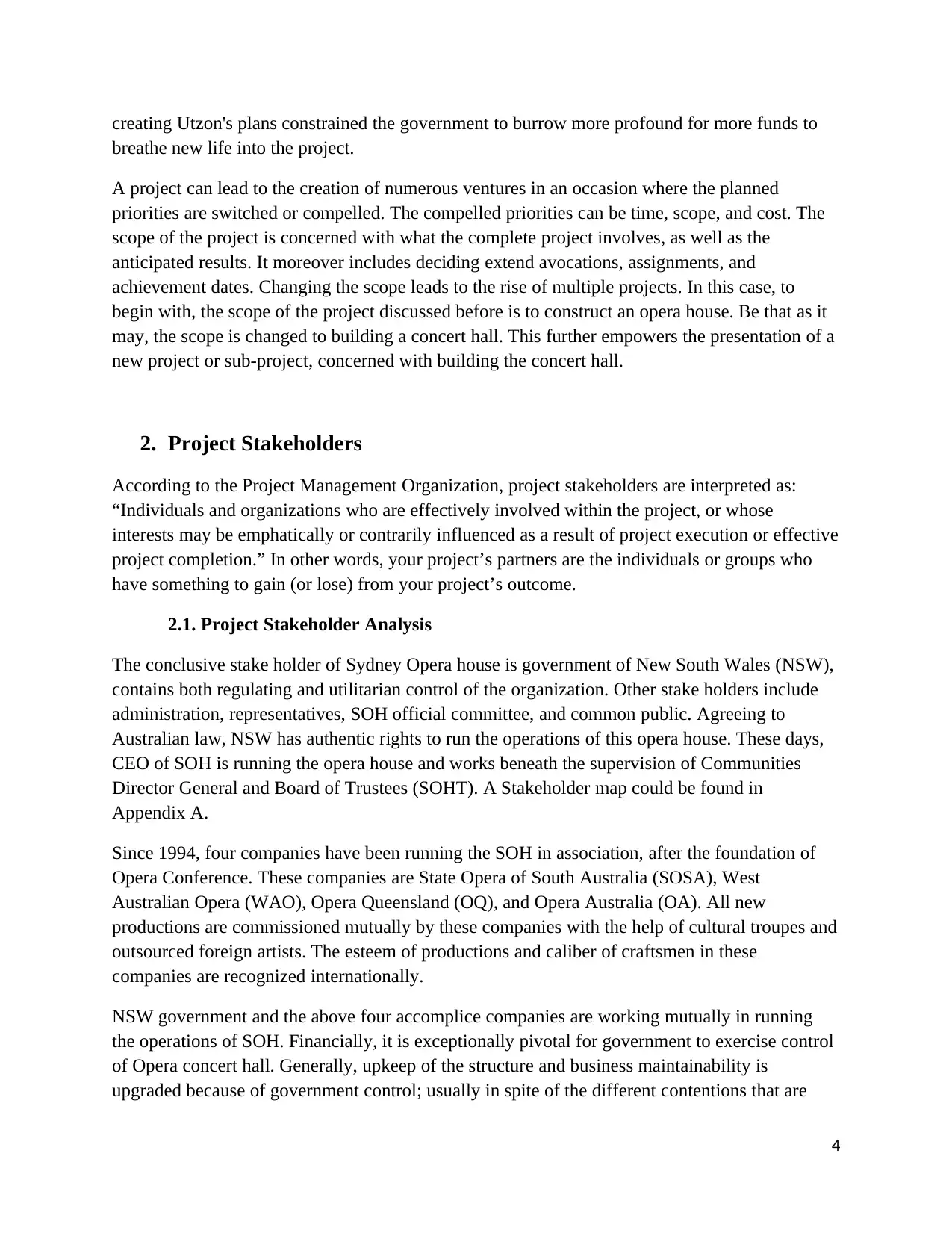
creating Utzon's plans constrained the government to burrow more profound for more funds to
breathe new life into the project.
A project can lead to the creation of numerous ventures in an occasion where the planned
priorities are switched or compelled. The compelled priorities can be time, scope, and cost. The
scope of the project is concerned with what the complete project involves, as well as the
anticipated results. It moreover includes deciding extend avocations, assignments, and
achievement dates. Changing the scope leads to the rise of multiple projects. In this case, to
begin with, the scope of the project discussed before is to construct an opera house. Be that as it
may, the scope is changed to building a concert hall. This further empowers the presentation of a
new project or sub-project, concerned with building the concert hall.
2. Project Stakeholders
According to the Project Management Organization, project stakeholders are interpreted as:
“Individuals and organizations who are effectively involved within the project, or whose
interests may be emphatically or contrarily influenced as a result of project execution or effective
project completion.” In other words, your project’s partners are the individuals or groups who
have something to gain (or lose) from your project’s outcome.
2.1. Project Stakeholder Analysis
The conclusive stake holder of Sydney Opera house is government of New South Wales (NSW),
contains both regulating and utilitarian control of the organization. Other stake holders include
administration, representatives, SOH official committee, and common public. Agreeing to
Australian law, NSW has authentic rights to run the operations of this opera house. These days,
CEO of SOH is running the opera house and works beneath the supervision of Communities
Director General and Board of Trustees (SOHT). A Stakeholder map could be found in
Appendix A.
Since 1994, four companies have been running the SOH in association, after the foundation of
Opera Conference. These companies are State Opera of South Australia (SOSA), West
Australian Opera (WAO), Opera Queensland (OQ), and Opera Australia (OA). All new
productions are commissioned mutually by these companies with the help of cultural troupes and
outsourced foreign artists. The esteem of productions and caliber of craftsmen in these
companies are recognized internationally.
NSW government and the above four accomplice companies are working mutually in running
the operations of SOH. Financially, it is exceptionally pivotal for government to exercise control
of Opera concert hall. Generally, upkeep of the structure and business maintainability is
upgraded because of government control; usually in spite of the different contentions that are
4
breathe new life into the project.
A project can lead to the creation of numerous ventures in an occasion where the planned
priorities are switched or compelled. The compelled priorities can be time, scope, and cost. The
scope of the project is concerned with what the complete project involves, as well as the
anticipated results. It moreover includes deciding extend avocations, assignments, and
achievement dates. Changing the scope leads to the rise of multiple projects. In this case, to
begin with, the scope of the project discussed before is to construct an opera house. Be that as it
may, the scope is changed to building a concert hall. This further empowers the presentation of a
new project or sub-project, concerned with building the concert hall.
2. Project Stakeholders
According to the Project Management Organization, project stakeholders are interpreted as:
“Individuals and organizations who are effectively involved within the project, or whose
interests may be emphatically or contrarily influenced as a result of project execution or effective
project completion.” In other words, your project’s partners are the individuals or groups who
have something to gain (or lose) from your project’s outcome.
2.1. Project Stakeholder Analysis
The conclusive stake holder of Sydney Opera house is government of New South Wales (NSW),
contains both regulating and utilitarian control of the organization. Other stake holders include
administration, representatives, SOH official committee, and common public. Agreeing to
Australian law, NSW has authentic rights to run the operations of this opera house. These days,
CEO of SOH is running the opera house and works beneath the supervision of Communities
Director General and Board of Trustees (SOHT). A Stakeholder map could be found in
Appendix A.
Since 1994, four companies have been running the SOH in association, after the foundation of
Opera Conference. These companies are State Opera of South Australia (SOSA), West
Australian Opera (WAO), Opera Queensland (OQ), and Opera Australia (OA). All new
productions are commissioned mutually by these companies with the help of cultural troupes and
outsourced foreign artists. The esteem of productions and caliber of craftsmen in these
companies are recognized internationally.
NSW government and the above four accomplice companies are working mutually in running
the operations of SOH. Financially, it is exceptionally pivotal for government to exercise control
of Opera concert hall. Generally, upkeep of the structure and business maintainability is
upgraded because of government control; usually in spite of the different contentions that are
4
Secure Best Marks with AI Grader
Need help grading? Try our AI Grader for instant feedback on your assignments.
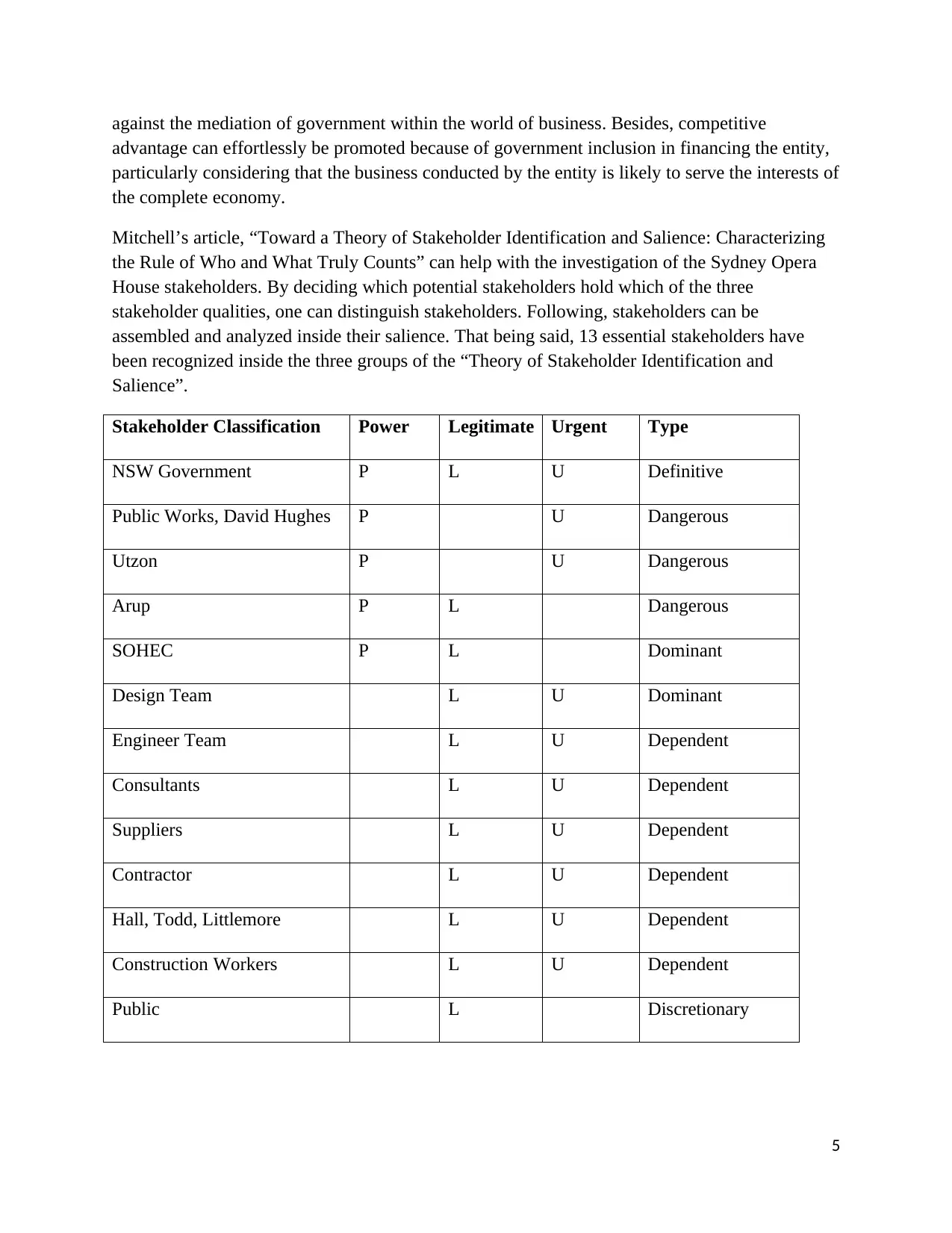
against the mediation of government within the world of business. Besides, competitive
advantage can effortlessly be promoted because of government inclusion in financing the entity,
particularly considering that the business conducted by the entity is likely to serve the interests of
the complete economy.
Mitchell’s article, “Toward a Theory of Stakeholder Identification and Salience: Characterizing
the Rule of Who and What Truly Counts” can help with the investigation of the Sydney Opera
House stakeholders. By deciding which potential stakeholders hold which of the three
stakeholder qualities, one can distinguish stakeholders. Following, stakeholders can be
assembled and analyzed inside their salience. That being said, 13 essential stakeholders have
been recognized inside the three groups of the “Theory of Stakeholder Identification and
Salience”.
Stakeholder Classification Power Legitimate Urgent Type
NSW Government P L U Definitive
Public Works, David Hughes P U Dangerous
Utzon P U Dangerous
Arup P L Dangerous
SOHEC P L Dominant
Design Team L U Dominant
Engineer Team L U Dependent
Consultants L U Dependent
Suppliers L U Dependent
Contractor L U Dependent
Hall, Todd, Littlemore L U Dependent
Construction Workers L U Dependent
Public L Discretionary
5
advantage can effortlessly be promoted because of government inclusion in financing the entity,
particularly considering that the business conducted by the entity is likely to serve the interests of
the complete economy.
Mitchell’s article, “Toward a Theory of Stakeholder Identification and Salience: Characterizing
the Rule of Who and What Truly Counts” can help with the investigation of the Sydney Opera
House stakeholders. By deciding which potential stakeholders hold which of the three
stakeholder qualities, one can distinguish stakeholders. Following, stakeholders can be
assembled and analyzed inside their salience. That being said, 13 essential stakeholders have
been recognized inside the three groups of the “Theory of Stakeholder Identification and
Salience”.
Stakeholder Classification Power Legitimate Urgent Type
NSW Government P L U Definitive
Public Works, David Hughes P U Dangerous
Utzon P U Dangerous
Arup P L Dangerous
SOHEC P L Dominant
Design Team L U Dominant
Engineer Team L U Dependent
Consultants L U Dependent
Suppliers L U Dependent
Contractor L U Dependent
Hall, Todd, Littlemore L U Dependent
Construction Workers L U Dependent
Public L Discretionary
5
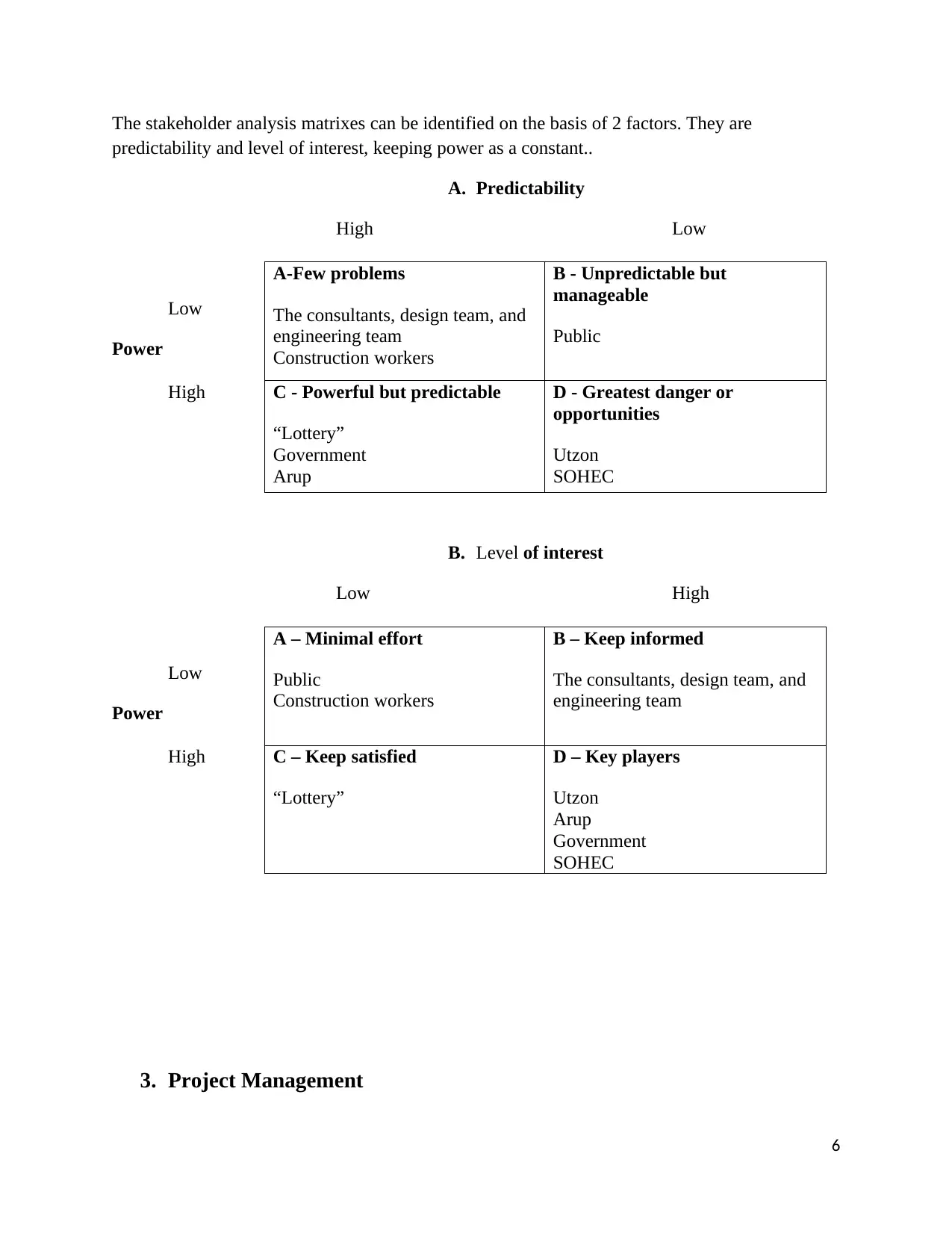
The stakeholder analysis matrixes can be identified on the basis of 2 factors. They are
predictability and level of interest, keeping power as a constant..
A. Predictability
High Low
Low
Power
High
B. Level of interest
Low High
Low
Power
High
3. Project Management
6
A-Few problems
The consultants, design team, and
engineering team
Construction workers
B - Unpredictable but
manageable
Public
C - Powerful but predictable
“Lottery”
Government
Arup
D - Greatest danger or
opportunities
Utzon
SOHEC
A – Minimal effort
Public
Construction workers
B – Keep informed
The consultants, design team, and
engineering team
C – Keep satisfied
“Lottery”
D – Key players
Utzon
Arup
Government
SOHEC
predictability and level of interest, keeping power as a constant..
A. Predictability
High Low
Low
Power
High
B. Level of interest
Low High
Low
Power
High
3. Project Management
6
A-Few problems
The consultants, design team, and
engineering team
Construction workers
B - Unpredictable but
manageable
Public
C - Powerful but predictable
“Lottery”
Government
Arup
D - Greatest danger or
opportunities
Utzon
SOHEC
A – Minimal effort
Public
Construction workers
B – Keep informed
The consultants, design team, and
engineering team
C – Keep satisfied
“Lottery”
D – Key players
Utzon
Arup
Government
SOHEC
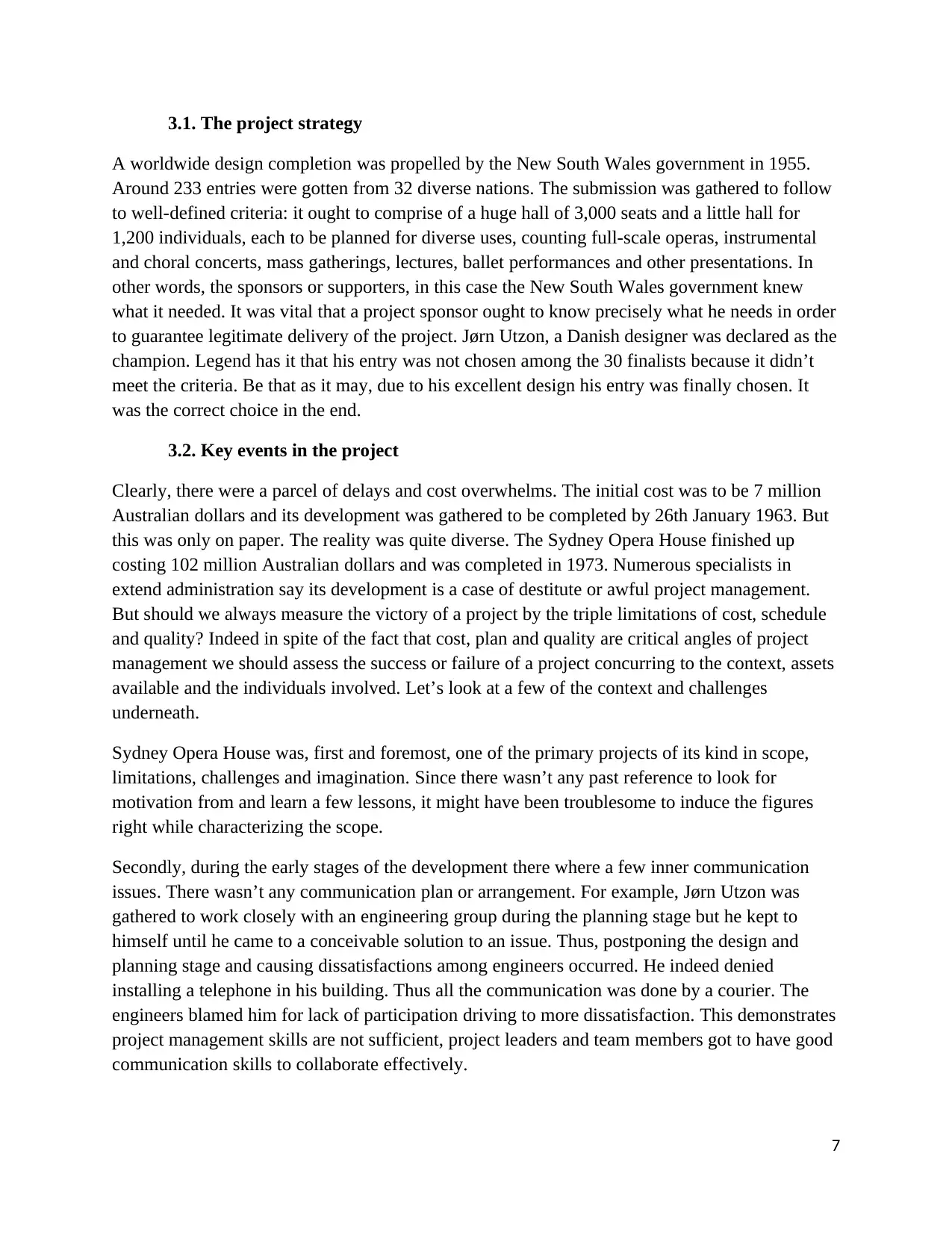
3.1. The project strategy
A worldwide design completion was propelled by the New South Wales government in 1955.
Around 233 entries were gotten from 32 diverse nations. The submission was gathered to follow
to well-defined criteria: it ought to comprise of a huge hall of 3,000 seats and a little hall for
1,200 individuals, each to be planned for diverse uses, counting full-scale operas, instrumental
and choral concerts, mass gatherings, lectures, ballet performances and other presentations. In
other words, the sponsors or supporters, in this case the New South Wales government knew
what it needed. It was vital that a project sponsor ought to know precisely what he needs in order
to guarantee legitimate delivery of the project. Jørn Utzon, a Danish designer was declared as the
champion. Legend has it that his entry was not chosen among the 30 finalists because it didn’t
meet the criteria. Be that as it may, due to his excellent design his entry was finally chosen. It
was the correct choice in the end.
3.2. Key events in the project
Clearly, there were a parcel of delays and cost overwhelms. The initial cost was to be 7 million
Australian dollars and its development was gathered to be completed by 26th January 1963. But
this was only on paper. The reality was quite diverse. The Sydney Opera House finished up
costing 102 million Australian dollars and was completed in 1973. Numerous specialists in
extend administration say its development is a case of destitute or awful project management.
But should we always measure the victory of a project by the triple limitations of cost, schedule
and quality? Indeed in spite of the fact that cost, plan and quality are critical angles of project
management we should assess the success or failure of a project concurring to the context, assets
available and the individuals involved. Let’s look at a few of the context and challenges
underneath.
Sydney Opera House was, first and foremost, one of the primary projects of its kind in scope,
limitations, challenges and imagination. Since there wasn’t any past reference to look for
motivation from and learn a few lessons, it might have been troublesome to induce the figures
right while characterizing the scope.
Secondly, during the early stages of the development there where a few inner communication
issues. There wasn’t any communication plan or arrangement. For example, Jørn Utzon was
gathered to work closely with an engineering group during the planning stage but he kept to
himself until he came to a conceivable solution to an issue. Thus, postponing the design and
planning stage and causing dissatisfactions among engineers occurred. He indeed denied
installing a telephone in his building. Thus all the communication was done by a courier. The
engineers blamed him for lack of participation driving to more dissatisfaction. This demonstrates
project management skills are not sufficient, project leaders and team members got to have good
communication skills to collaborate effectively.
7
A worldwide design completion was propelled by the New South Wales government in 1955.
Around 233 entries were gotten from 32 diverse nations. The submission was gathered to follow
to well-defined criteria: it ought to comprise of a huge hall of 3,000 seats and a little hall for
1,200 individuals, each to be planned for diverse uses, counting full-scale operas, instrumental
and choral concerts, mass gatherings, lectures, ballet performances and other presentations. In
other words, the sponsors or supporters, in this case the New South Wales government knew
what it needed. It was vital that a project sponsor ought to know precisely what he needs in order
to guarantee legitimate delivery of the project. Jørn Utzon, a Danish designer was declared as the
champion. Legend has it that his entry was not chosen among the 30 finalists because it didn’t
meet the criteria. Be that as it may, due to his excellent design his entry was finally chosen. It
was the correct choice in the end.
3.2. Key events in the project
Clearly, there were a parcel of delays and cost overwhelms. The initial cost was to be 7 million
Australian dollars and its development was gathered to be completed by 26th January 1963. But
this was only on paper. The reality was quite diverse. The Sydney Opera House finished up
costing 102 million Australian dollars and was completed in 1973. Numerous specialists in
extend administration say its development is a case of destitute or awful project management.
But should we always measure the victory of a project by the triple limitations of cost, schedule
and quality? Indeed in spite of the fact that cost, plan and quality are critical angles of project
management we should assess the success or failure of a project concurring to the context, assets
available and the individuals involved. Let’s look at a few of the context and challenges
underneath.
Sydney Opera House was, first and foremost, one of the primary projects of its kind in scope,
limitations, challenges and imagination. Since there wasn’t any past reference to look for
motivation from and learn a few lessons, it might have been troublesome to induce the figures
right while characterizing the scope.
Secondly, during the early stages of the development there where a few inner communication
issues. There wasn’t any communication plan or arrangement. For example, Jørn Utzon was
gathered to work closely with an engineering group during the planning stage but he kept to
himself until he came to a conceivable solution to an issue. Thus, postponing the design and
planning stage and causing dissatisfactions among engineers occurred. He indeed denied
installing a telephone in his building. Thus all the communication was done by a courier. The
engineers blamed him for lack of participation driving to more dissatisfaction. This demonstrates
project management skills are not sufficient, project leaders and team members got to have good
communication skills to collaborate effectively.
7
Paraphrase This Document
Need a fresh take? Get an instant paraphrase of this document with our AI Paraphraser
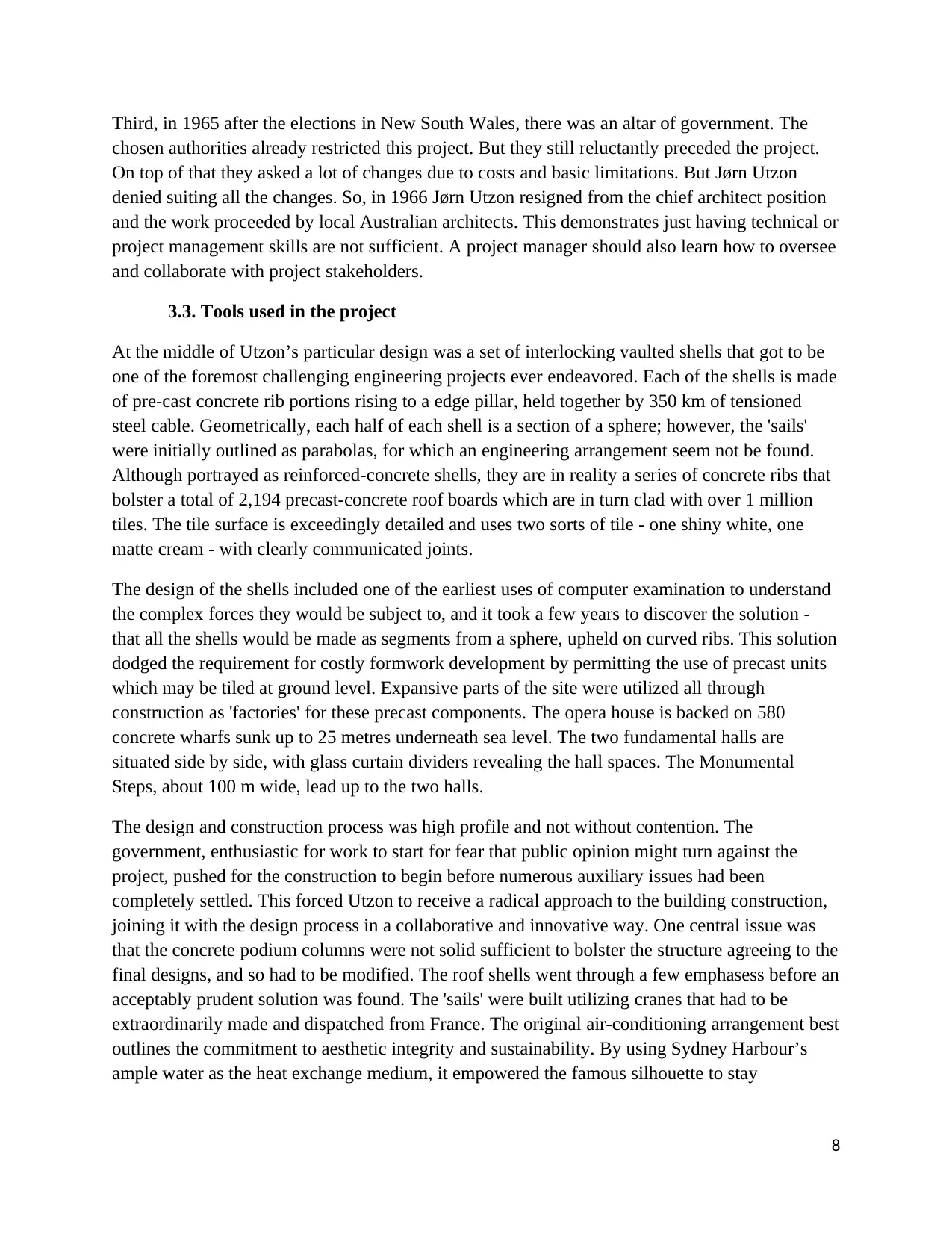
Third, in 1965 after the elections in New South Wales, there was an altar of government. The
chosen authorities already restricted this project. But they still reluctantly preceded the project.
On top of that they asked a lot of changes due to costs and basic limitations. But Jørn Utzon
denied suiting all the changes. So, in 1966 Jørn Utzon resigned from the chief architect position
and the work proceeded by local Australian architects. This demonstrates just having technical or
project management skills are not sufficient. A project manager should also learn how to oversee
and collaborate with project stakeholders.
3.3. Tools used in the project
At the middle of Utzon’s particular design was a set of interlocking vaulted shells that got to be
one of the foremost challenging engineering projects ever endeavored. Each of the shells is made
of pre-cast concrete rib portions rising to a edge pillar, held together by 350 km of tensioned
steel cable. Geometrically, each half of each shell is a section of a sphere; however, the 'sails'
were initially outlined as parabolas, for which an engineering arrangement seem not be found.
Although portrayed as reinforced-concrete shells, they are in reality a series of concrete ribs that
bolster a total of 2,194 precast-concrete roof boards which are in turn clad with over 1 million
tiles. The tile surface is exceedingly detailed and uses two sorts of tile - one shiny white, one
matte cream - with clearly communicated joints.
The design of the shells included one of the earliest uses of computer examination to understand
the complex forces they would be subject to, and it took a few years to discover the solution -
that all the shells would be made as segments from a sphere, upheld on curved ribs. This solution
dodged the requirement for costly formwork development by permitting the use of precast units
which may be tiled at ground level. Expansive parts of the site were utilized all through
construction as 'factories' for these precast components. The opera house is backed on 580
concrete wharfs sunk up to 25 metres underneath sea level. The two fundamental halls are
situated side by side, with glass curtain dividers revealing the hall spaces. The Monumental
Steps, about 100 m wide, lead up to the two halls.
The design and construction process was high profile and not without contention. The
government, enthusiastic for work to start for fear that public opinion might turn against the
project, pushed for the construction to begin before numerous auxiliary issues had been
completely settled. This forced Utzon to receive a radical approach to the building construction,
joining it with the design process in a collaborative and innovative way. One central issue was
that the concrete podium columns were not solid sufficient to bolster the structure agreeing to the
final designs, and so had to be modified. The roof shells went through a few emphasess before an
acceptably prudent solution was found. The 'sails' were built utilizing cranes that had to be
extraordinarily made and dispatched from France. The original air-conditioning arrangement best
outlines the commitment to aesthetic integrity and sustainability. By using Sydney Harbour’s
ample water as the heat exchange medium, it empowered the famous silhouette to stay
8
chosen authorities already restricted this project. But they still reluctantly preceded the project.
On top of that they asked a lot of changes due to costs and basic limitations. But Jørn Utzon
denied suiting all the changes. So, in 1966 Jørn Utzon resigned from the chief architect position
and the work proceeded by local Australian architects. This demonstrates just having technical or
project management skills are not sufficient. A project manager should also learn how to oversee
and collaborate with project stakeholders.
3.3. Tools used in the project
At the middle of Utzon’s particular design was a set of interlocking vaulted shells that got to be
one of the foremost challenging engineering projects ever endeavored. Each of the shells is made
of pre-cast concrete rib portions rising to a edge pillar, held together by 350 km of tensioned
steel cable. Geometrically, each half of each shell is a section of a sphere; however, the 'sails'
were initially outlined as parabolas, for which an engineering arrangement seem not be found.
Although portrayed as reinforced-concrete shells, they are in reality a series of concrete ribs that
bolster a total of 2,194 precast-concrete roof boards which are in turn clad with over 1 million
tiles. The tile surface is exceedingly detailed and uses two sorts of tile - one shiny white, one
matte cream - with clearly communicated joints.
The design of the shells included one of the earliest uses of computer examination to understand
the complex forces they would be subject to, and it took a few years to discover the solution -
that all the shells would be made as segments from a sphere, upheld on curved ribs. This solution
dodged the requirement for costly formwork development by permitting the use of precast units
which may be tiled at ground level. Expansive parts of the site were utilized all through
construction as 'factories' for these precast components. The opera house is backed on 580
concrete wharfs sunk up to 25 metres underneath sea level. The two fundamental halls are
situated side by side, with glass curtain dividers revealing the hall spaces. The Monumental
Steps, about 100 m wide, lead up to the two halls.
The design and construction process was high profile and not without contention. The
government, enthusiastic for work to start for fear that public opinion might turn against the
project, pushed for the construction to begin before numerous auxiliary issues had been
completely settled. This forced Utzon to receive a radical approach to the building construction,
joining it with the design process in a collaborative and innovative way. One central issue was
that the concrete podium columns were not solid sufficient to bolster the structure agreeing to the
final designs, and so had to be modified. The roof shells went through a few emphasess before an
acceptably prudent solution was found. The 'sails' were built utilizing cranes that had to be
extraordinarily made and dispatched from France. The original air-conditioning arrangement best
outlines the commitment to aesthetic integrity and sustainability. By using Sydney Harbour’s
ample water as the heat exchange medium, it empowered the famous silhouette to stay
8
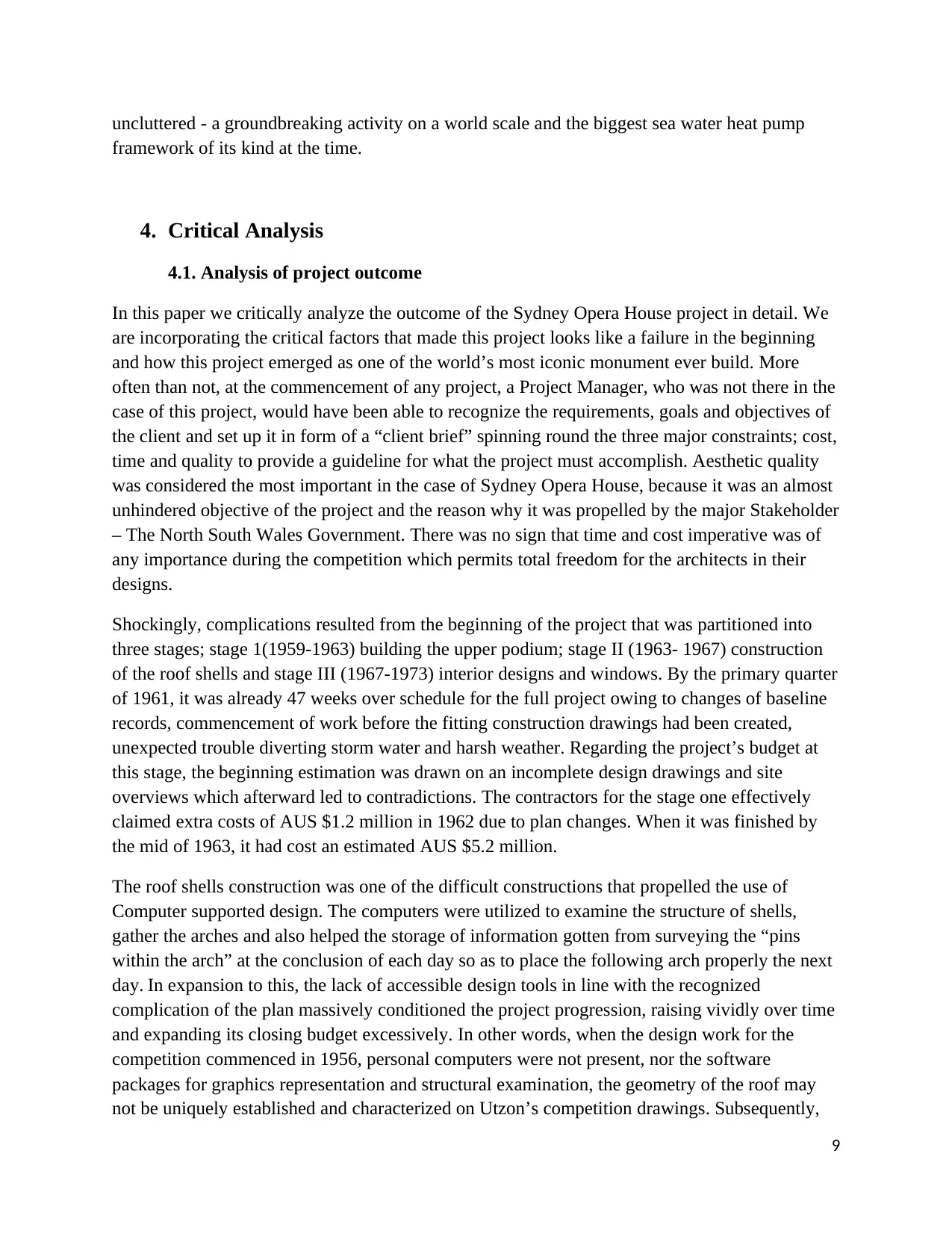
uncluttered - a groundbreaking activity on a world scale and the biggest sea water heat pump
framework of its kind at the time.
4. Critical Analysis
4.1. Analysis of project outcome
In this paper we critically analyze the outcome of the Sydney Opera House project in detail. We
are incorporating the critical factors that made this project looks like a failure in the beginning
and how this project emerged as one of the world’s most iconic monument ever build. More
often than not, at the commencement of any project, a Project Manager, who was not there in the
case of this project, would have been able to recognize the requirements, goals and objectives of
the client and set up it in form of a “client brief” spinning round the three major constraints; cost,
time and quality to provide a guideline for what the project must accomplish. Aesthetic quality
was considered the most important in the case of Sydney Opera House, because it was an almost
unhindered objective of the project and the reason why it was propelled by the major Stakeholder
– The North South Wales Government. There was no sign that time and cost imperative was of
any importance during the competition which permits total freedom for the architects in their
designs.
Shockingly, complications resulted from the beginning of the project that was partitioned into
three stages; stage 1(1959-1963) building the upper podium; stage II (1963- 1967) construction
of the roof shells and stage III (1967-1973) interior designs and windows. By the primary quarter
of 1961, it was already 47 weeks over schedule for the full project owing to changes of baseline
records, commencement of work before the fitting construction drawings had been created,
unexpected trouble diverting storm water and harsh weather. Regarding the project’s budget at
this stage, the beginning estimation was drawn on an incomplete design drawings and site
overviews which afterward led to contradictions. The contractors for the stage one effectively
claimed extra costs of AUS $1.2 million in 1962 due to plan changes. When it was finished by
the mid of 1963, it had cost an estimated AUS $5.2 million.
The roof shells construction was one of the difficult constructions that propelled the use of
Computer supported design. The computers were utilized to examine the structure of shells,
gather the arches and also helped the storage of information gotten from surveying the “pins
within the arch” at the conclusion of each day so as to place the following arch properly the next
day. In expansion to this, the lack of accessible design tools in line with the recognized
complication of the plan massively conditioned the project progression, raising vividly over time
and expanding its closing budget excessively. In other words, when the design work for the
competition commenced in 1956, personal computers were not present, nor the software
packages for graphics representation and structural examination, the geometry of the roof may
not be uniquely established and characterized on Utzon’s competition drawings. Subsequently,
9
framework of its kind at the time.
4. Critical Analysis
4.1. Analysis of project outcome
In this paper we critically analyze the outcome of the Sydney Opera House project in detail. We
are incorporating the critical factors that made this project looks like a failure in the beginning
and how this project emerged as one of the world’s most iconic monument ever build. More
often than not, at the commencement of any project, a Project Manager, who was not there in the
case of this project, would have been able to recognize the requirements, goals and objectives of
the client and set up it in form of a “client brief” spinning round the three major constraints; cost,
time and quality to provide a guideline for what the project must accomplish. Aesthetic quality
was considered the most important in the case of Sydney Opera House, because it was an almost
unhindered objective of the project and the reason why it was propelled by the major Stakeholder
– The North South Wales Government. There was no sign that time and cost imperative was of
any importance during the competition which permits total freedom for the architects in their
designs.
Shockingly, complications resulted from the beginning of the project that was partitioned into
three stages; stage 1(1959-1963) building the upper podium; stage II (1963- 1967) construction
of the roof shells and stage III (1967-1973) interior designs and windows. By the primary quarter
of 1961, it was already 47 weeks over schedule for the full project owing to changes of baseline
records, commencement of work before the fitting construction drawings had been created,
unexpected trouble diverting storm water and harsh weather. Regarding the project’s budget at
this stage, the beginning estimation was drawn on an incomplete design drawings and site
overviews which afterward led to contradictions. The contractors for the stage one effectively
claimed extra costs of AUS $1.2 million in 1962 due to plan changes. When it was finished by
the mid of 1963, it had cost an estimated AUS $5.2 million.
The roof shells construction was one of the difficult constructions that propelled the use of
Computer supported design. The computers were utilized to examine the structure of shells,
gather the arches and also helped the storage of information gotten from surveying the “pins
within the arch” at the conclusion of each day so as to place the following arch properly the next
day. In expansion to this, the lack of accessible design tools in line with the recognized
complication of the plan massively conditioned the project progression, raising vividly over time
and expanding its closing budget excessively. In other words, when the design work for the
competition commenced in 1956, personal computers were not present, nor the software
packages for graphics representation and structural examination, the geometry of the roof may
not be uniquely established and characterized on Utzon’s competition drawings. Subsequently,
9
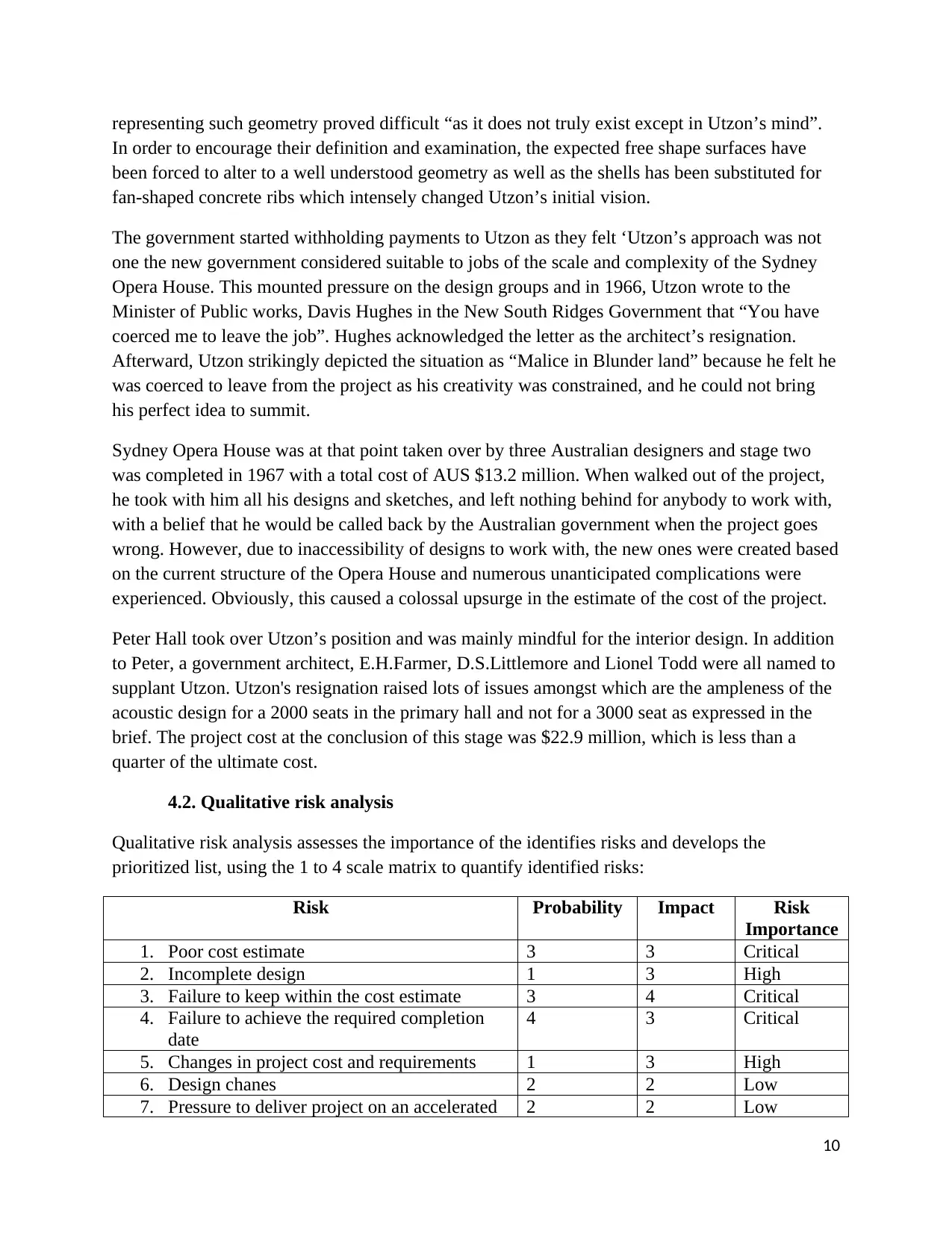
representing such geometry proved difficult “as it does not truly exist except in Utzon’s mind”.
In order to encourage their definition and examination, the expected free shape surfaces have
been forced to alter to a well understood geometry as well as the shells has been substituted for
fan-shaped concrete ribs which intensely changed Utzon’s initial vision.
The government started withholding payments to Utzon as they felt ‘Utzon’s approach was not
one the new government considered suitable to jobs of the scale and complexity of the Sydney
Opera House. This mounted pressure on the design groups and in 1966, Utzon wrote to the
Minister of Public works, Davis Hughes in the New South Ridges Government that “You have
coerced me to leave the job”. Hughes acknowledged the letter as the architect’s resignation.
Afterward, Utzon strikingly depicted the situation as “Malice in Blunder land” because he felt he
was coerced to leave from the project as his creativity was constrained, and he could not bring
his perfect idea to summit.
Sydney Opera House was at that point taken over by three Australian designers and stage two
was completed in 1967 with a total cost of AUS $13.2 million. When walked out of the project,
he took with him all his designs and sketches, and left nothing behind for anybody to work with,
with a belief that he would be called back by the Australian government when the project goes
wrong. However, due to inaccessibility of designs to work with, the new ones were created based
on the current structure of the Opera House and numerous unanticipated complications were
experienced. Obviously, this caused a colossal upsurge in the estimate of the cost of the project.
Peter Hall took over Utzon’s position and was mainly mindful for the interior design. In addition
to Peter, a government architect, E.H.Farmer, D.S.Littlemore and Lionel Todd were all named to
supplant Utzon. Utzon's resignation raised lots of issues amongst which are the ampleness of the
acoustic design for a 2000 seats in the primary hall and not for a 3000 seat as expressed in the
brief. The project cost at the conclusion of this stage was $22.9 million, which is less than a
quarter of the ultimate cost.
4.2. Qualitative risk analysis
Qualitative risk analysis assesses the importance of the identifies risks and develops the
prioritized list, using the 1 to 4 scale matrix to quantify identified risks:
Risk Probability Impact Risk
Importance
1. Poor cost estimate 3 3 Critical
2. Incomplete design 1 3 High
3. Failure to keep within the cost estimate 3 4 Critical
4. Failure to achieve the required completion
date
4 3 Critical
5. Changes in project cost and requirements 1 3 High
6. Design chanes 2 2 Low
7. Pressure to deliver project on an accelerated 2 2 Low
10
In order to encourage their definition and examination, the expected free shape surfaces have
been forced to alter to a well understood geometry as well as the shells has been substituted for
fan-shaped concrete ribs which intensely changed Utzon’s initial vision.
The government started withholding payments to Utzon as they felt ‘Utzon’s approach was not
one the new government considered suitable to jobs of the scale and complexity of the Sydney
Opera House. This mounted pressure on the design groups and in 1966, Utzon wrote to the
Minister of Public works, Davis Hughes in the New South Ridges Government that “You have
coerced me to leave the job”. Hughes acknowledged the letter as the architect’s resignation.
Afterward, Utzon strikingly depicted the situation as “Malice in Blunder land” because he felt he
was coerced to leave from the project as his creativity was constrained, and he could not bring
his perfect idea to summit.
Sydney Opera House was at that point taken over by three Australian designers and stage two
was completed in 1967 with a total cost of AUS $13.2 million. When walked out of the project,
he took with him all his designs and sketches, and left nothing behind for anybody to work with,
with a belief that he would be called back by the Australian government when the project goes
wrong. However, due to inaccessibility of designs to work with, the new ones were created based
on the current structure of the Opera House and numerous unanticipated complications were
experienced. Obviously, this caused a colossal upsurge in the estimate of the cost of the project.
Peter Hall took over Utzon’s position and was mainly mindful for the interior design. In addition
to Peter, a government architect, E.H.Farmer, D.S.Littlemore and Lionel Todd were all named to
supplant Utzon. Utzon's resignation raised lots of issues amongst which are the ampleness of the
acoustic design for a 2000 seats in the primary hall and not for a 3000 seat as expressed in the
brief. The project cost at the conclusion of this stage was $22.9 million, which is less than a
quarter of the ultimate cost.
4.2. Qualitative risk analysis
Qualitative risk analysis assesses the importance of the identifies risks and develops the
prioritized list, using the 1 to 4 scale matrix to quantify identified risks:
Risk Probability Impact Risk
Importance
1. Poor cost estimate 3 3 Critical
2. Incomplete design 1 3 High
3. Failure to keep within the cost estimate 3 4 Critical
4. Failure to achieve the required completion
date
4 3 Critical
5. Changes in project cost and requirements 1 3 High
6. Design chanes 2 2 Low
7. Pressure to deliver project on an accelerated 2 2 Low
10
Secure Best Marks with AI Grader
Need help grading? Try our AI Grader for instant feedback on your assignments.
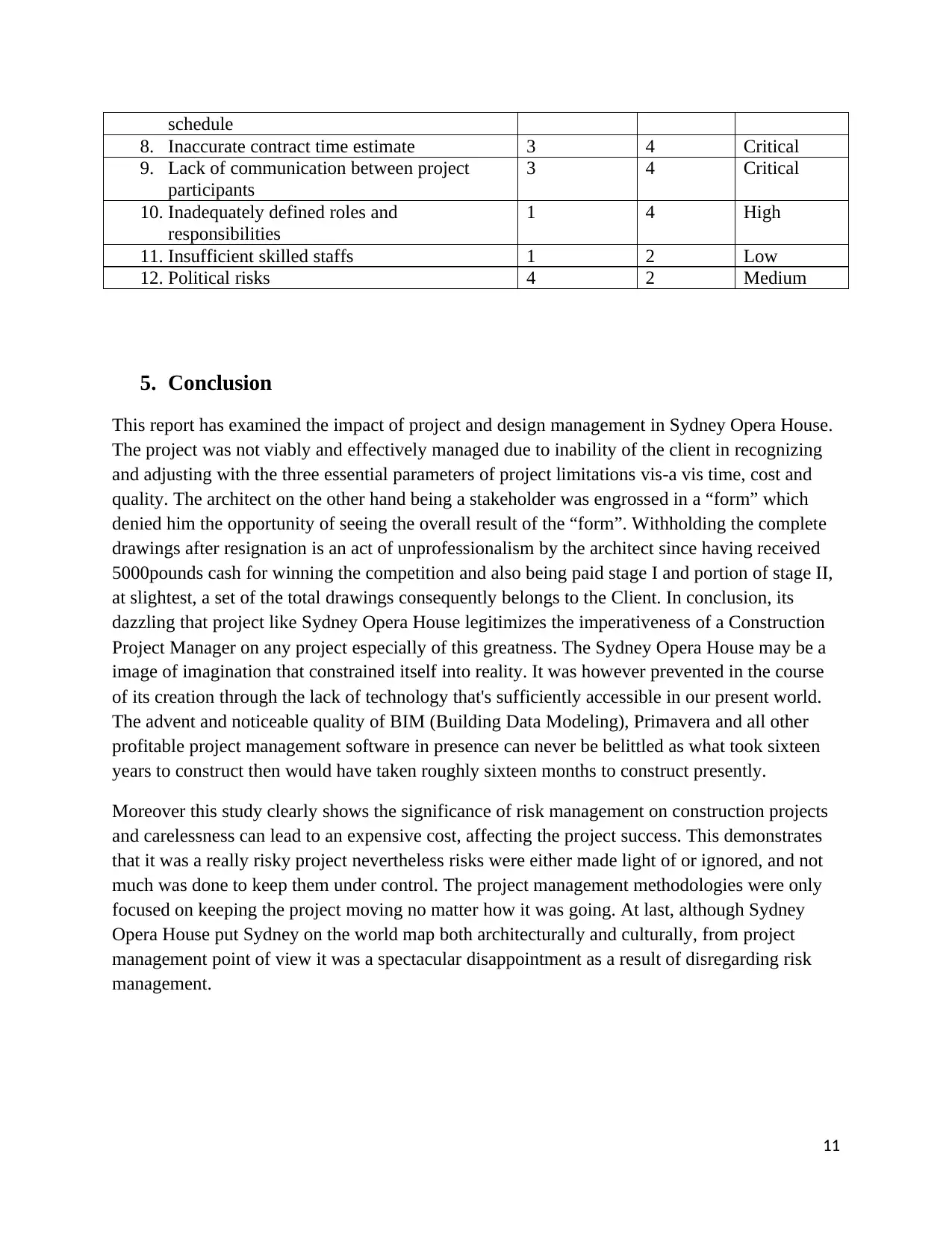
schedule
8. Inaccurate contract time estimate 3 4 Critical
9. Lack of communication between project
participants
3 4 Critical
10. Inadequately defined roles and
responsibilities
1 4 High
11. Insufficient skilled staffs 1 2 Low
12. Political risks 4 2 Medium
5. Conclusion
This report has examined the impact of project and design management in Sydney Opera House.
The project was not viably and effectively managed due to inability of the client in recognizing
and adjusting with the three essential parameters of project limitations vis-a vis time, cost and
quality. The architect on the other hand being a stakeholder was engrossed in a “form” which
denied him the opportunity of seeing the overall result of the “form”. Withholding the complete
drawings after resignation is an act of unprofessionalism by the architect since having received
5000pounds cash for winning the competition and also being paid stage I and portion of stage II,
at slightest, a set of the total drawings consequently belongs to the Client. In conclusion, its
dazzling that project like Sydney Opera House legitimizes the imperativeness of a Construction
Project Manager on any project especially of this greatness. The Sydney Opera House may be a
image of imagination that constrained itself into reality. It was however prevented in the course
of its creation through the lack of technology that's sufficiently accessible in our present world.
The advent and noticeable quality of BIM (Building Data Modeling), Primavera and all other
profitable project management software in presence can never be belittled as what took sixteen
years to construct then would have taken roughly sixteen months to construct presently.
Moreover this study clearly shows the significance of risk management on construction projects
and carelessness can lead to an expensive cost, affecting the project success. This demonstrates
that it was a really risky project nevertheless risks were either made light of or ignored, and not
much was done to keep them under control. The project management methodologies were only
focused on keeping the project moving no matter how it was going. At last, although Sydney
Opera House put Sydney on the world map both architecturally and culturally, from project
management point of view it was a spectacular disappointment as a result of disregarding risk
management.
11
8. Inaccurate contract time estimate 3 4 Critical
9. Lack of communication between project
participants
3 4 Critical
10. Inadequately defined roles and
responsibilities
1 4 High
11. Insufficient skilled staffs 1 2 Low
12. Political risks 4 2 Medium
5. Conclusion
This report has examined the impact of project and design management in Sydney Opera House.
The project was not viably and effectively managed due to inability of the client in recognizing
and adjusting with the three essential parameters of project limitations vis-a vis time, cost and
quality. The architect on the other hand being a stakeholder was engrossed in a “form” which
denied him the opportunity of seeing the overall result of the “form”. Withholding the complete
drawings after resignation is an act of unprofessionalism by the architect since having received
5000pounds cash for winning the competition and also being paid stage I and portion of stage II,
at slightest, a set of the total drawings consequently belongs to the Client. In conclusion, its
dazzling that project like Sydney Opera House legitimizes the imperativeness of a Construction
Project Manager on any project especially of this greatness. The Sydney Opera House may be a
image of imagination that constrained itself into reality. It was however prevented in the course
of its creation through the lack of technology that's sufficiently accessible in our present world.
The advent and noticeable quality of BIM (Building Data Modeling), Primavera and all other
profitable project management software in presence can never be belittled as what took sixteen
years to construct then would have taken roughly sixteen months to construct presently.
Moreover this study clearly shows the significance of risk management on construction projects
and carelessness can lead to an expensive cost, affecting the project success. This demonstrates
that it was a really risky project nevertheless risks were either made light of or ignored, and not
much was done to keep them under control. The project management methodologies were only
focused on keeping the project moving no matter how it was going. At last, although Sydney
Opera House put Sydney on the world map both architecturally and culturally, from project
management point of view it was a spectacular disappointment as a result of disregarding risk
management.
11
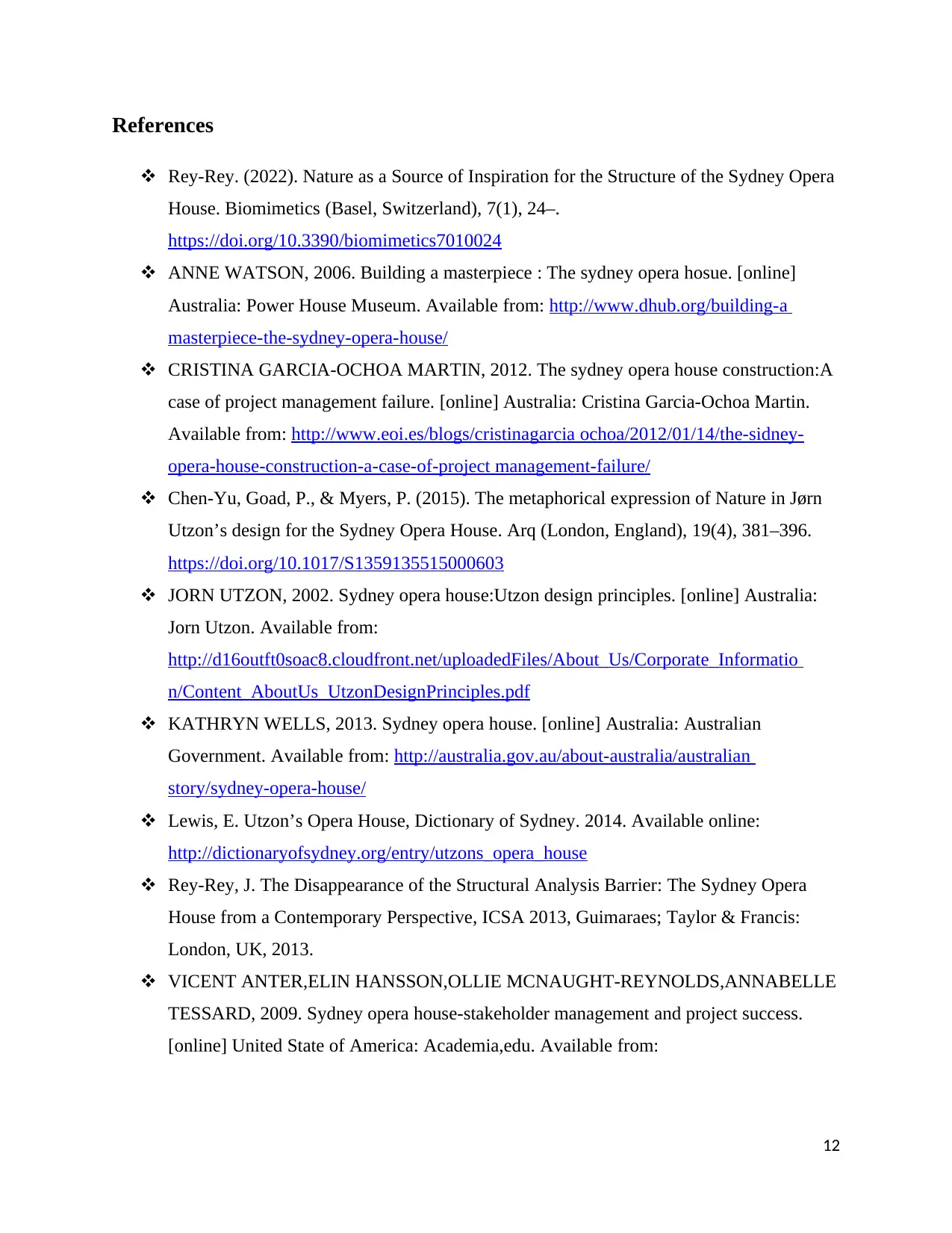
References
Rey-Rey. (2022). Nature as a Source of Inspiration for the Structure of the Sydney Opera
House. Biomimetics (Basel, Switzerland), 7(1), 24–.
https://doi.org/10.3390/biomimetics7010024
ANNE WATSON, 2006. Building a masterpiece : The sydney opera hosue. [online]
Australia: Power House Museum. Available from: http://www.dhub.org/building-a
masterpiece-the-sydney-opera-house/
CRISTINA GARCIA-OCHOA MARTIN, 2012. The sydney opera house construction:A
case of project management failure. [online] Australia: Cristina Garcia-Ochoa Martin.
Available from: http://www.eoi.es/blogs/cristinagarcia ochoa/2012/01/14/the-sidney-
opera-house-construction-a-case-of-project management-failure/
Chen-Yu, Goad, P., & Myers, P. (2015). The metaphorical expression of Nature in Jørn
Utzon’s design for the Sydney Opera House. Arq (London, England), 19(4), 381–396.
https://doi.org/10.1017/S1359135515000603
JORN UTZON, 2002. Sydney opera house:Utzon design principles. [online] Australia:
Jorn Utzon. Available from:
http://d16outft0soac8.cloudfront.net/uploadedFiles/About_Us/Corporate_Informatio
n/Content_AboutUs_UtzonDesignPrinciples.pdf
KATHRYN WELLS, 2013. Sydney opera house. [online] Australia: Australian
Government. Available from: http://australia.gov.au/about-australia/australian
story/sydney-opera-house/
Lewis, E. Utzon’s Opera House, Dictionary of Sydney. 2014. Available online:
http://dictionaryofsydney.org/entry/utzons_opera_house
Rey-Rey, J. The Disappearance of the Structural Analysis Barrier: The Sydney Opera
House from a Contemporary Perspective, ICSA 2013, Guimaraes; Taylor & Francis:
London, UK, 2013.
VICENT ANTER,ELIN HANSSON,OLLIE MCNAUGHT-REYNOLDS,ANNABELLE
TESSARD, 2009. Sydney opera house-stakeholder management and project success.
[online] United State of America: Academia,edu. Available from:
12
Rey-Rey. (2022). Nature as a Source of Inspiration for the Structure of the Sydney Opera
House. Biomimetics (Basel, Switzerland), 7(1), 24–.
https://doi.org/10.3390/biomimetics7010024
ANNE WATSON, 2006. Building a masterpiece : The sydney opera hosue. [online]
Australia: Power House Museum. Available from: http://www.dhub.org/building-a
masterpiece-the-sydney-opera-house/
CRISTINA GARCIA-OCHOA MARTIN, 2012. The sydney opera house construction:A
case of project management failure. [online] Australia: Cristina Garcia-Ochoa Martin.
Available from: http://www.eoi.es/blogs/cristinagarcia ochoa/2012/01/14/the-sidney-
opera-house-construction-a-case-of-project management-failure/
Chen-Yu, Goad, P., & Myers, P. (2015). The metaphorical expression of Nature in Jørn
Utzon’s design for the Sydney Opera House. Arq (London, England), 19(4), 381–396.
https://doi.org/10.1017/S1359135515000603
JORN UTZON, 2002. Sydney opera house:Utzon design principles. [online] Australia:
Jorn Utzon. Available from:
http://d16outft0soac8.cloudfront.net/uploadedFiles/About_Us/Corporate_Informatio
n/Content_AboutUs_UtzonDesignPrinciples.pdf
KATHRYN WELLS, 2013. Sydney opera house. [online] Australia: Australian
Government. Available from: http://australia.gov.au/about-australia/australian
story/sydney-opera-house/
Lewis, E. Utzon’s Opera House, Dictionary of Sydney. 2014. Available online:
http://dictionaryofsydney.org/entry/utzons_opera_house
Rey-Rey, J. The Disappearance of the Structural Analysis Barrier: The Sydney Opera
House from a Contemporary Perspective, ICSA 2013, Guimaraes; Taylor & Francis:
London, UK, 2013.
VICENT ANTER,ELIN HANSSON,OLLIE MCNAUGHT-REYNOLDS,ANNABELLE
TESSARD, 2009. Sydney opera house-stakeholder management and project success.
[online] United State of America: Academia,edu. Available from:
12
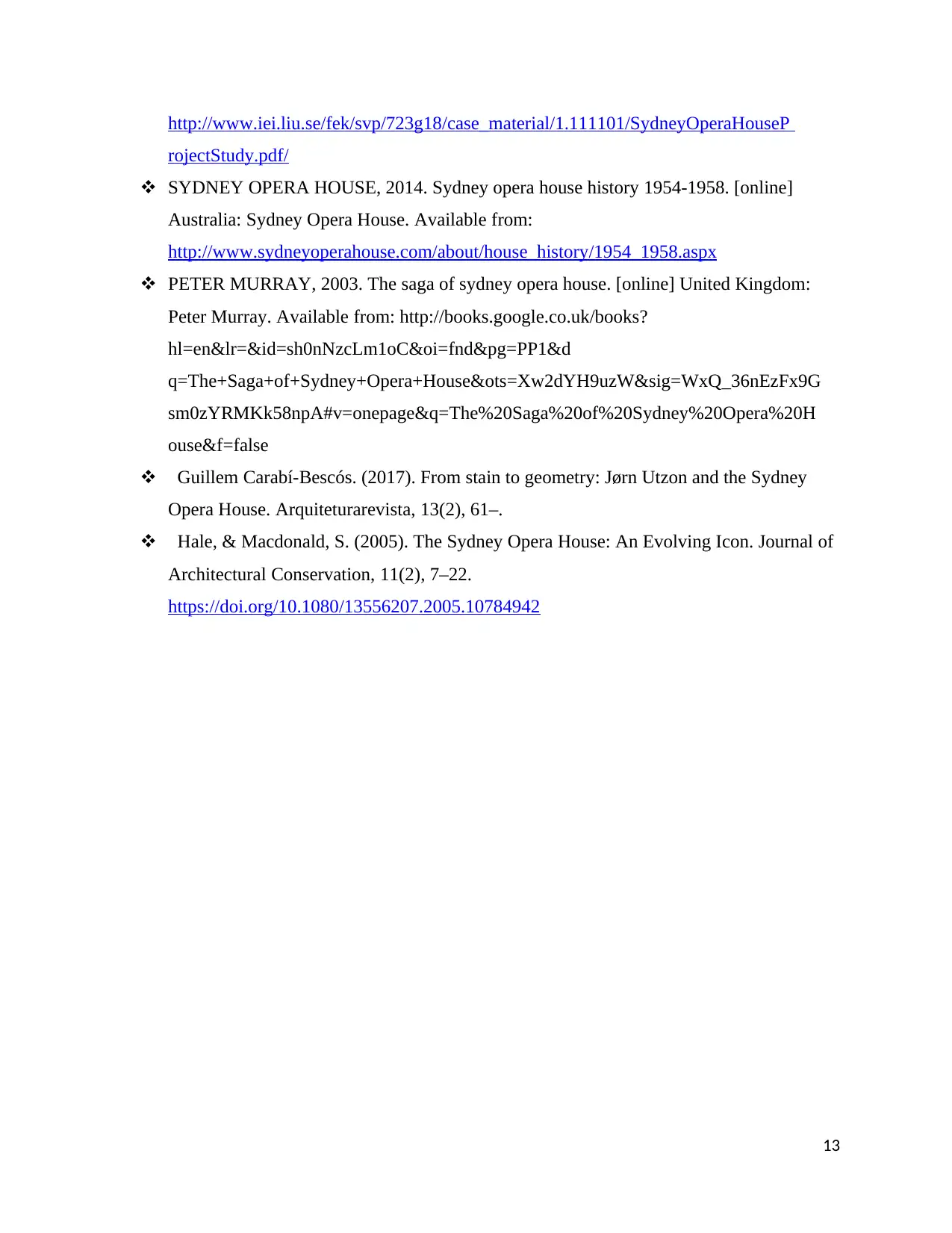
http://www.iei.liu.se/fek/svp/723g18/case_material/1.111101/SydneyOperaHouseP
rojectStudy.pdf/
SYDNEY OPERA HOUSE, 2014. Sydney opera house history 1954-1958. [online]
Australia: Sydney Opera House. Available from:
http://www.sydneyoperahouse.com/about/house_history/1954_1958.aspx
PETER MURRAY, 2003. The saga of sydney opera house. [online] United Kingdom:
Peter Murray. Available from: http://books.google.co.uk/books?
hl=en&lr=&id=sh0nNzcLm1oC&oi=fnd&pg=PP1&d
q=The+Saga+of+Sydney+Opera+House&ots=Xw2dYH9uzW&sig=WxQ_36nEzFx9G
sm0zYRMKk58npA#v=onepage&q=The%20Saga%20of%20Sydney%20Opera%20H
ouse&f=false
Guillem Carabí-Bescós. (2017). From stain to geometry: Jørn Utzon and the Sydney
Opera House. Arquiteturarevista, 13(2), 61–.
Hale, & Macdonald, S. (2005). The Sydney Opera House: An Evolving Icon. Journal of
Architectural Conservation, 11(2), 7–22.
https://doi.org/10.1080/13556207.2005.10784942
13
rojectStudy.pdf/
SYDNEY OPERA HOUSE, 2014. Sydney opera house history 1954-1958. [online]
Australia: Sydney Opera House. Available from:
http://www.sydneyoperahouse.com/about/house_history/1954_1958.aspx
PETER MURRAY, 2003. The saga of sydney opera house. [online] United Kingdom:
Peter Murray. Available from: http://books.google.co.uk/books?
hl=en&lr=&id=sh0nNzcLm1oC&oi=fnd&pg=PP1&d
q=The+Saga+of+Sydney+Opera+House&ots=Xw2dYH9uzW&sig=WxQ_36nEzFx9G
sm0zYRMKk58npA#v=onepage&q=The%20Saga%20of%20Sydney%20Opera%20H
ouse&f=false
Guillem Carabí-Bescós. (2017). From stain to geometry: Jørn Utzon and the Sydney
Opera House. Arquiteturarevista, 13(2), 61–.
Hale, & Macdonald, S. (2005). The Sydney Opera House: An Evolving Icon. Journal of
Architectural Conservation, 11(2), 7–22.
https://doi.org/10.1080/13556207.2005.10784942
13
Paraphrase This Document
Need a fresh take? Get an instant paraphrase of this document with our AI Paraphraser
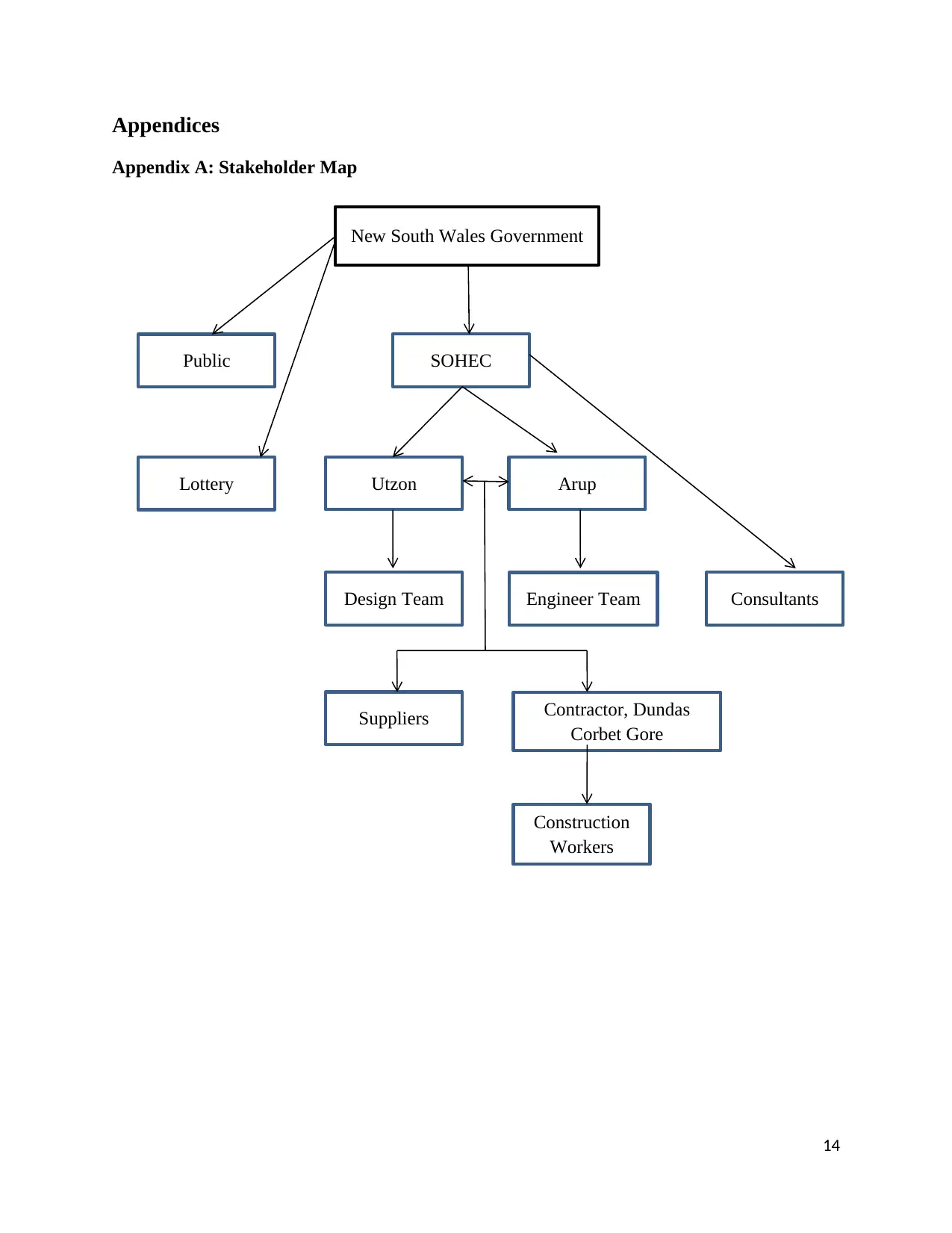
Appendices
Appendix A: Stakeholder Map
14
New South Wales Government
Public SOHEC
Lottery Utzon Arup
Design Team Engineer Team Consultants
Suppliers Contractor, Dundas
Corbet Gore
Construction
Workers
Appendix A: Stakeholder Map
14
New South Wales Government
Public SOHEC
Lottery Utzon Arup
Design Team Engineer Team Consultants
Suppliers Contractor, Dundas
Corbet Gore
Construction
Workers
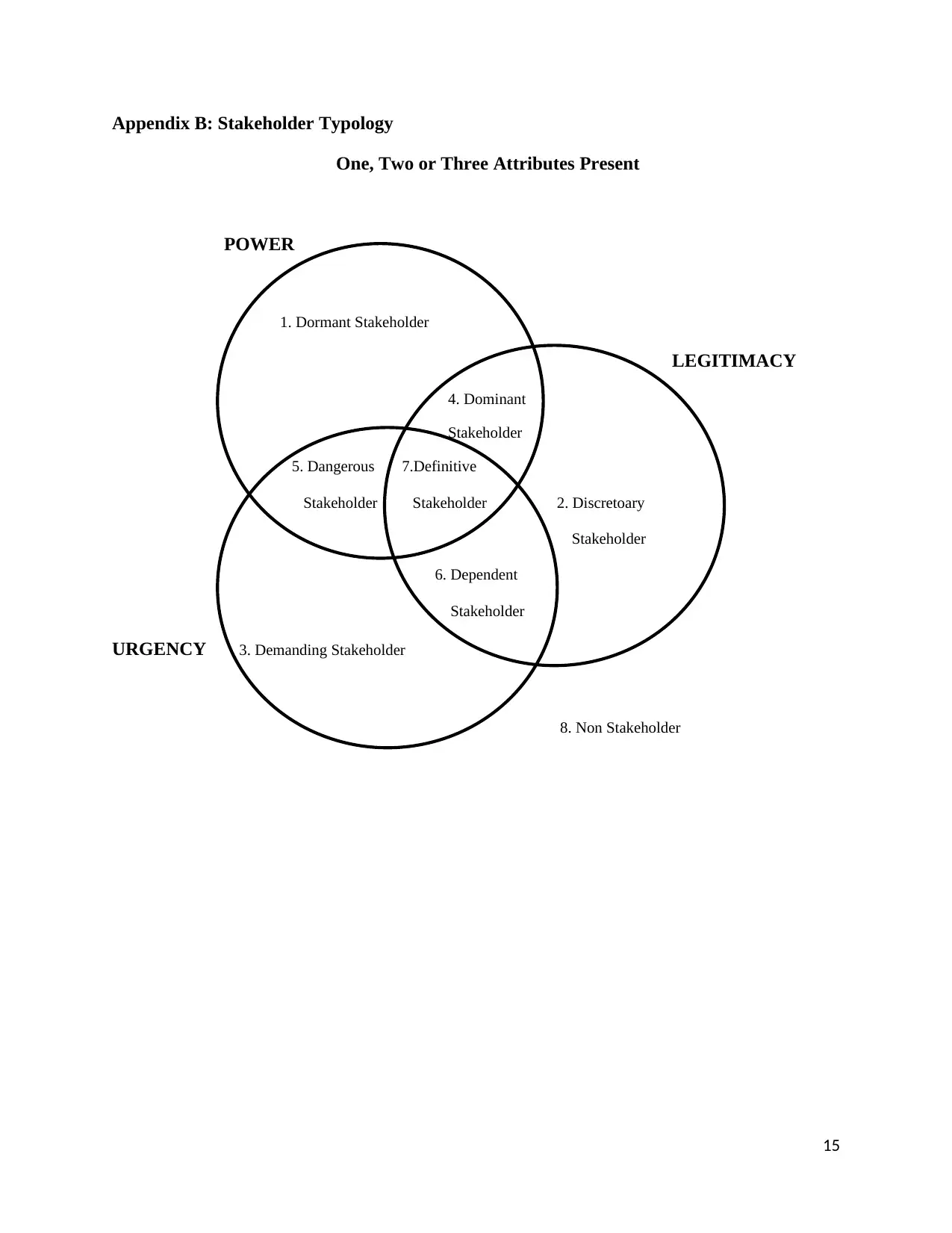
Appendix B: Stakeholder Typology
One, Two or Three Attributes Present
POWER
1. Dormant Stakeholder
LEGITIMACY
4. Dominant
Stakeholder
5. Dangerous 7.Definitive
Stakeholder Stakeholder 2. Discretoary
Stakeholder
6. Dependent
Stakeholder
URGENCY 3. Demanding Stakeholder
8. Non Stakeholder
15
One, Two or Three Attributes Present
POWER
1. Dormant Stakeholder
LEGITIMACY
4. Dominant
Stakeholder
5. Dangerous 7.Definitive
Stakeholder Stakeholder 2. Discretoary
Stakeholder
6. Dependent
Stakeholder
URGENCY 3. Demanding Stakeholder
8. Non Stakeholder
15
1 out of 15
Related Documents
Your All-in-One AI-Powered Toolkit for Academic Success.
+13062052269
info@desklib.com
Available 24*7 on WhatsApp / Email
![[object Object]](/_next/static/media/star-bottom.7253800d.svg)
Unlock your academic potential
© 2024 | Zucol Services PVT LTD | All rights reserved.





